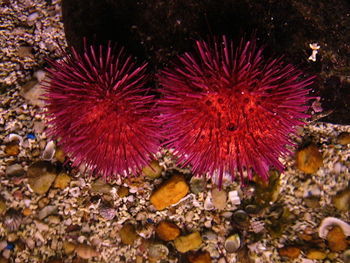Effects of heavy metals on the sperm quality and the larvae survival of sea urchins
Context of the study
Paracentrotus lividus, the dominant sea urchin in the Mediterranean, is highly sensitive to various chemicals. Therefore, it is used to asses the environmental impacts and toxic effects of numerous pollutants. In the Mediterranean several sites have been reported to be contaminated by heavy metals. To fully understand the toxicity of a pollutant, it's important to know the different effects of different doses.[1]
Content of the study
The study aimed to determine the toxicity of 4 heavy metals (mercury (Hg), copper (Cu), silver (Ag), and cadmium (Cd)), on the fertilization and the early development of this sea urchin.
Main results of the study
Exposure of the sea urchin sperm to high concentrations of the 4 heavy metals affected their fertility. Lower concentrations of Hg (10-7M) were necessary to obtain the same results, than of Ag or Cu (both 10-6M). Even higher concentrations of Cd (10-5M) were needed to affect the sea urchin's sperm cells. The offspring that did develop out of exposed sperm cells didn't display any abnormalities. These concentrations are much higher than those commonly reported from the North Sea, but they do occur in heavily polluted area's in the Mediterranean. However, in the experiment the sperm cells were exposed for periods of 30 min, while in natural conditions they are only for 5 minutes in free water before fertilization. Therefore, this experiment doesn't allow conclusions for natural conditions.
The lowest concentrations that proved toxic for the larvae were 100 times lower for Hg, Ag and Cu (10--7M, 2.5*10--7M and 5*10-7M respectively) than for Cd (10-5M). Each metal induced different development defects in the larvae. The severity of these development defects depended on the concentration of the heavy metal they were exposed to. Since these concentrations occur in heavily polluted area's, or could occur after accidental major spills, heavy metals could in some area's impair the development of this sea urchin. [1]
References
Please note that others may also have edited the contents of this article.
|
